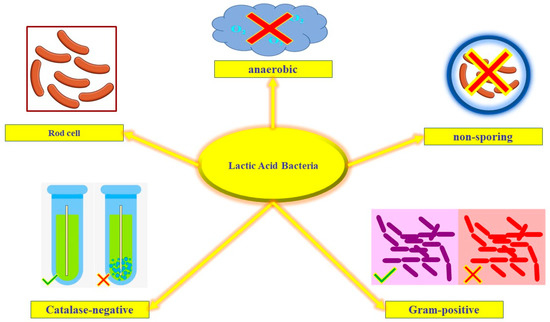Meat and some meat products are highly perishable due to their high-water content, pH, and high content of nutrients. Therefore, spoilage control in these products is one of the critical challenges in the food industry. On the other hand, the increasing widespread awareness about the undesirable effects of synthetic preservatives has promoted the breakthrough of the use of natural compounds or bio-preservation technology. Bio-preservation implies the application of microorganisms or their metabolites to extend the shelf life of food products. In this regard, according to the ancient and safe use of fermentation by lactic acid bacteria (LAB), their application in the bio-preservation of meat and meat products is gaining more attention.
- bio-preservation
- fermentation
- lactic acid bacteria
- meat products
- natural anti-microbial
1. Introduction
2. Fermented Meat Products and Their Health-Beneficial Properties
In the past, different techniques were used and developed for the preservation of meat and meat products, starting with adding some ingredients, such as salt and sugar to reduce microorganisms without an exact understanding of their preservative mechanisms. But today, the use of microorganisms in terms of fermentation of meat and meat products is known as an effective preservation method [5]. Microbial enzymatic activities during fermentation leads to various physicochemical and microbial changes based on the meat components (natural or added components) [26]. Fermentation can occur by two pathways: (1) the use of natural microflora of meat or (2) the use of starter cultures such as lactic acid bacteria and micrococci. Lactic acid bacteria breakdown the carbohydrates and micrococci reduce nitrates and nitrites to nitric oxide that leads to production of volatile and nonvolatile compounds and flavor and odor changes of the product [27]. Also, fermentation causes different health-beneficial properties in fermented meat products in comparison to non-fermented ones such as antioxidant, antimicrobial, anti-hypertensive, and antithrombotic [28][29][28,29]. Furthermore, some nutritional components are produced during fermentation that have the potential to prevent diabetes, cancers, and allergic sensitization [30]. More studies are needed to discover other health-beneficial potentials of these products and their exact mechanisms. Also, these products should be evaluated in terms of food safety.3. A Brief Overview on LAB
LAB are part of the natural microbial flora of fermented meats and the intestinal microbiota of humans. These aerotolerant bacteria are mainly non-sporing, Gram-positive, Catalase-negative, and have either a spherical-shaped or rod-shaped cell (Figure 1) [31]. LAB are microaerophilic organisms and preferably require anaerobic conditions for growth. They play an important role in food fermentations; in fact, LAB can ferment carbohydrates to high amounts of lactic acid as the final product (homofermentative bacteria); in addition to lactic acid, heterofermentative bacteria produce acetic acid, carbon dioxide, and ethanol, as by-products [32]. These organisms are acidophilus with the optimum acidic pH values of 5.5–6.2, but few can tolerate pH as low as 3.0 [33]. LAB are Generally Regarded As Safe (GRAS) according to the FDA and the European Food Safety Authority (EFSA) that have granted many LAB species Qualified Presumption of Safety status (QPS) [25][34][35][25,34,35]. Lactic acid bacteria possess considerable bioactive properties such as cholesterol reduction and antimicrobial properties, which has led to an increased interest in their effective role as preservatives in innovative food preservation technology, much more than their application in traditional fermentation [36][37][38][36,37,38]. The antibacterial activity of LAB strains has been proven in different studies [39]. It has been reported that different LAB strains secrete various compounds that inhibit bacterial growth such as diacetyl, phenyl-lactate, organic acids, hydroxy fatty acid, hydroxy phenyl-lactate, hydrogen peroxide, propionate, and cyclic dipeptides. These bacteria also secrete biosurfactants, bacteriocins (i.e., acidophilin, lactacin, bifidocin, helveticin, plantarim, pediocin, bulgaricin, diplococcin, and nisin), and bacteriocin-like inhibitory substances [40][41][40,41].
3.1. LAB Strains Involved in Fermented Meat Products
The technological characterization of LAB strains involved in the fermentation process of meat is essential to select the best strain to be utilized as starter cultures [42]. The genera Lactobacillus, Carnobacterium, Weissella, Pediococcus, Enterococcus, and Leuconostoc are the main LAB that play crucial role in the fermentation [42][43][42,43]. The list of some of GRAS LAB that are most commonly used in bio-preservation of meat and meat products are mentioned in Table 1. Members of the genus Lactobacillus are usually the dominant species in most fermented meat products, but in some slightly acidified sausages, both Enterococcus and Lactobacillus are present in similar amounts [43]; nevertheless, Lactobacillus plantarum and Lactobacillus curvatus are the most common LAB species in fermented sausages [26]. It has been reported that in many fermented sausages, Lactobacillus sakei has the most adaptability due to a higher maximum growth rate, higher final cell density, and a shorter lag phase [44][45][44,45]. It should be noted that in Southern European sausages, the most and least common species are Lactobacillus sakei and Pediococci spp., respectively [46]. Also, molds, such as Penicillium chrysogenum and Penicillium nalgiovense, are commonly used for sausage ripening in Southern Europe [47]. In artisan sausages from Southern Europe, a strain of Enterococcus faecium grows increasingly during the early stages of fermentation, producing a bacteriocin [48]. It has been reported that yeast genera, especially Debaryomyces hansenii, can be found in fermented meat products with appropriate organoleptic characteristics [49][50][49,50].Genus | Species | Genus | Species |
|---|
Product | Bio-Preservative Agent | Results | References | |||||||||||||
|---|---|---|---|---|---|---|---|---|---|---|---|---|---|---|---|---|
Lactobacillus | Lactobacillus delbrueckii | Lacticaseibacillus | Lacticaseibacillus paracasei | |||||||||||||
Ground beef | L. reuteri or L. plantarum in combination with garlic extract | 1.4 and 1.5 log reduction of L. monocytogenes by using L. reuteri or L. plantarum in combination with 1% of garlic extract |
[56] |
[116] |
||||||||||||
Lactobacillus bulgaricus | Lacticaseibacillus rhamnosus | |||||||||||||||
Beef sausage | Bacteriocinogenic Enterococcus mundtii and 0.0075% ascorbic acid, 3% NaCl, 0.02% NaNO2, 0.75% glucose and 0.75% sucrose | >2 log cfu/g reduction of L. monocytogenes |
[57] |
[117] |
Lactobacillus gallinarum | Lacticaseibacillus casei | ||||||||||
Lactobacillus gasseri | ||||||||||||||||
Sliced beef | Bacteriocin from C. maltaromaticum combined with steam and chitosan | No synergistic effect 2 log reduction of S. typhimurium, E. coli and S. typhimurium |
[58] |
[118] |
||||||||||||
Minced beef meat | Pediococcus | Pediococcus acidilactici | ||||||||||||||
Mentha piperita essential oil with semipurified bacteriocin | Reduction in Enterobacteriaceae |
[59] |
[119] |
Lactobacillus lactis | ||||||||||||
Frozen ground beef patties | Pediococcus pentosaceus | |||||||||||||||
Bacteriocin-producing L. curvatus and L. lactis in combination with Na2EDTA | 1 log reduction of E. coli |
[60] |
[120] |
Lactobacillus helveticus | ||||||||||||
Fresh chicken meat burger | Pediococcus parvulus | |||||||||||||||
L. pseudomesenteroides combined with MAP (50% CO2 and 50% O2) | Reduction in L. monocytogenes and C. jejuni |
[55] |
[115] |
Lactobacillus reuteri | Leuconostoc | |||||||||||
Fresh pork sausage | Combination of essential oils, nisin, nitrite, and organic acid salts, encapsulated | Leuconostoc mesenteroides | ||||||||||||||
Reduction in L. monocytogenes |
[61] |
[121] |
Lactobacillus acidophilus | Leuconostoc citreum | ||||||||||||
Alheira paste | L. sakei and L. plantarum, vacuum packed or packed under MAP (20% CO2, 80% N2) | 2 log reduction in L. monocytogenes by L. sakei. No significant differences between vacuum or MAP |
[62] |
[122] |
Lactobacillus curvatus | Leuconostoc pseudomesenteroides | ||||||||||
Sliced lombo | Combination of Bacteriocin from P. acidilactici with HPP | Reduction in L. innocua |
[63] |
[123] |
Lactobacillus sakei | Leuconostoc carnosum | ||||||||||
Lactobacillusalivarius | ||||||||||||||||
Lactiplantibacillus | Lactiplantibacillus pentosus | Latilactobacillus | Latilactobacillus sakei | |||||||||||||
Lactiplantibacillus plantarum | Latilactobacillus curvatus | |||||||||||||||
Lactiplantibacillus brevis | Limosilactobacillus | Limosilactobacillus fermentum | ||||||||||||||
Lactiplantibacillus casei | Limosilactobacillus reuteri |
3.2. Bio-Preservation of Meat and Meat Products by LAB and Their Metabolites
3.3. LAB or Their Metabolites as a Part of Hurdle Technology
Hurdle technology refers to the combination of different preservative factors such as water activity (aw), temperature, redox potential (Eh), and novel preservative techniques, such as gas packaging, natural extracts, essential oils, and bacteriocins, to create more selective and efficient defensive systems to overcome pathogenic and spoilage microorganisms [52][69]. So, LAB and their metabolites can be used as a part of hurdles technology that act synergistically and inhibit food spoilage in combination with other preservative agents. In this way, less intensities of technological treatment and/or doses of preservative agents are required [53][113]. In the application of different antimicrobial agents, it is very important to select the best combination, so that desirable preservative effects are achieved. In this regard, it has been reported that the addition of chelating agents makes the outer membranes of Gram-negative bacteria more permeable and sensitive to the hydrophobic peptides such as bacteriocins [54][Goat meat emulsion | ||||||||||
Combination of Pediocin from | ||||||||||
P. pentosaceus | ||||||||||
and | Murraya koenigii berries extract | Reduction in L. innocua |
[64] |
[124] |
||||||
Ready-to-eat porkham | Bacteriocin-like inhibitory substances (BLIS) from P. pentosaceus and nisin | Inhibition of growth of L. seeligeri |
[65] |
[76] |
3.4. Kinetics Models for Microbial Inactivation

